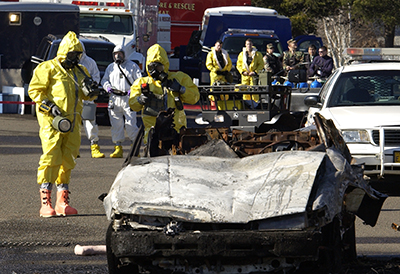Dear Dr. Zoomie – I just read in the news today that they caught criminals trying to sell radioactive and nuclear materials to ISIS in Moldova. What gives? I thought it took a nation to make a nuclear weapon – I’m assuming I should be scared; how scared should I be? Do I need to update my life insurance?
The threat of radiological and nuclear terrorism has been a concern for a number of years and this article is only the latest of a number of articles on this threat. There’s a lot in here so let’s take things one at a time, starting with the easiest.
The article mentions the isotope Cs-135 (cesium-135) as possibly being available for purchase by terrorist organizations to use to make a radiological dispersal device (the so-called “dirty bomb”). There’s been a lot written about dirty bombs and I won’t add to that here except to note that ISIS has mentioned their pursuit (or possession) of radioactive materials to use in making such a device. This particular isotope (Cs-135) is an odd one to mention – it’s neither as widely used nor as dangerous as Cs-137 – it’s produced in nuclear reactors but is usually disposed of as radioactive waste. It also has a fairly long half-life (so it’s not intensely radioactive) and it emits beta radiation, which is not terribly dangerous. So this nuclide could be used as a nuisance, but it poses much less health risk than Cs-137. The fact that this nuclide is being offered suggests that either the person doesn’t know exactly which nuclide they have, that they’re making something up, or that they have access to spent (or reprocessed) reactor fuel or nuclides that can be scavenged from it.

The article also mentions plutonium. There is a fissionable isotope of plutonium that’s used in nuclear weapons (Pu-239) but this is produced in nuclear reactors and then must be chemically separated from the spent fuel using some fairly complex chemistry. Pu-239 is too valuable as a fissionable material to be used in a dirty bomb, and it’s a lot harder to fashion into a nuclear weapon than is uranium – chances are that, if plutonium is being sold as a potential RDD material, it’s more likely to be Pu-238. Pu-238 is fairly common – although it’s not fissionable (so it can’t be used to make nuclear weapon) it is fairly highly radioactive. Its primary use is in spacecraft in the form of radioisotopic thermal generators (RTGs) due to the high levels of heat emitted by the decay of Pu-238 atoms. It’s also toxic, although (contrary to common misconception) it’s not the most toxic substance known to science. In any event, an RDD made with Pu-238 would be a great way to make a mess, but it’s not likely to put many (if any) people at risk since the radiation it gives off (alpha radiation) is fairly innocuous unless it’s inhaled or ingested. It would, however, make a huge mess – it could contaminate a large area, cause a huge financial impact, and would likely cause a degree of panic – but the perceived health risk would very likely far outstrip the actual danger.
Finally we get to the weapons-grade uranium that was mentioned. The nuclear weapon that was dropped on Hiroshima contained a little over 60 kg of highly enriched uranium; this story mentions that the seller had 100 grams of weapons grade uranium with him and promised to deliver it in 1-kg batches at a cost of about $32 million per batch. To make a Little Boy-type device would require over 60 transactions and a total cost of two billion dollars. The financial part of it is beyond the reach of most (but not all) of our enemies – this narrows the list of potential buyers. Equally important is the sheer number of transactions that would need to take place for a terrorist group (or rogue nation) to get their hands on a bomb’s—worth of material. Sixty transactions greatly increases the odds of being caught by law enforcement or intelligence agencies and having the whole plot unwind. This isn’t to say that this would be impossible – but the more complex a plan is, the less likely it is that it will be successful. It’s certainly possible that a criminal organization might have access to large quantities of weapons-grade uranium, but it’s also possible (perhaps more likely) that the seller has just enough of the material to get rich and that the supply would dry up after just a handful of sales. So, while we have to take this report seriously, I’m not sure that it’s time to start buying nuclear bomb insurance.
Taking all of this together, what have we got?
Well, first we now that there’s a continuing interest in putting radiological or nuclear materials into the hands of groups that wish us ill. And if organized crime organizations really have found sources of radiological or nuclear materials – and if they have found buyers – the possibility of an attack of some sort is quite possibly higher today than in the past. On the other hand, there have been attempts at radiological and nuclear smuggling for at least a decade – what makes this report different is the apparent involvement of organized crime. The biggest unknown is whether this group has access to enough uranium to make a weapon and whether or not a terrorist group has access to enough money to buy it all. Right now we just don’t know the answers to these questions.